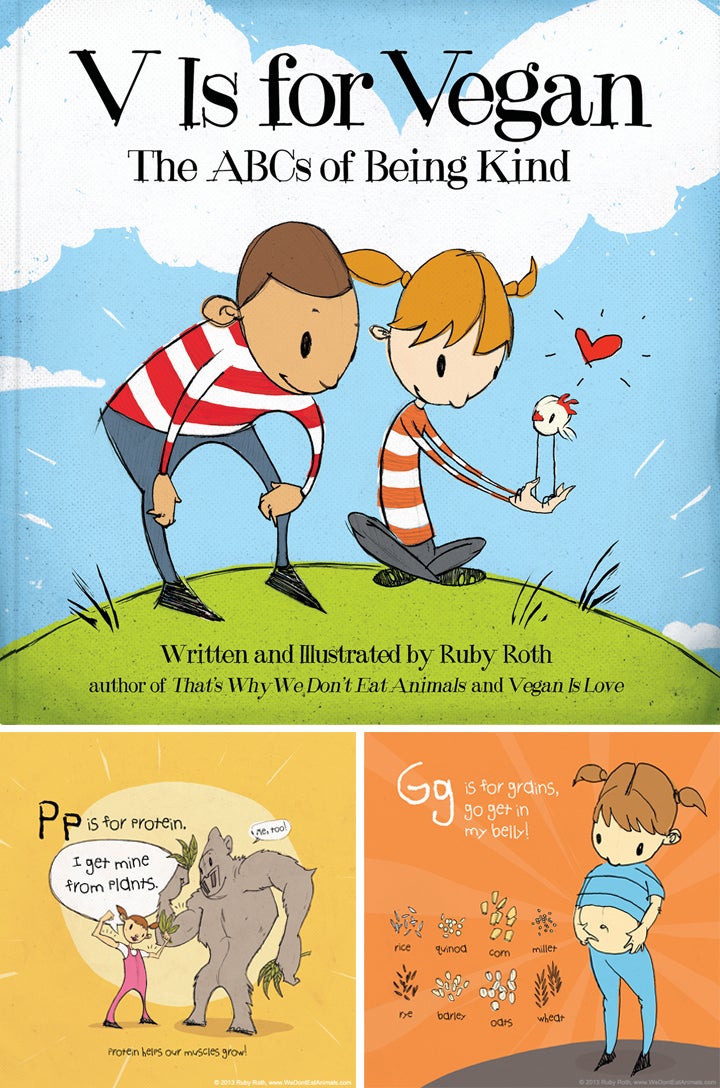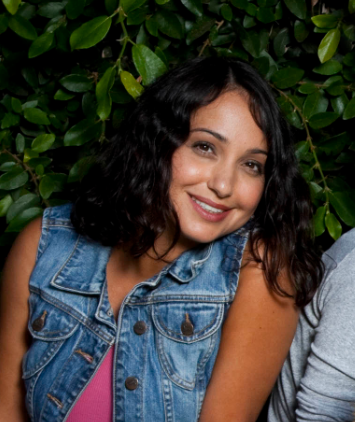Heading out the door? Read this article on the new Outside+ app available now on iOS devices for members! Download the app.

Move over Shel Silverstein and Dr. Seuss—make some room on the book shelf for a new, welcome series of children’s books—one that teaches “The ABCs of Being Kind”—both to animals and to our planet. From the author-illlustrator of the much-loved That’s Why We Don’t Eat Animals and Vegan is Love, Ruby Roth, comes the just-released V is for Vegan, an uplifting and educational picture book that introduces young readers to animal rights and environmental issues and the virtues of a plant-based diet. Below, Roth dishes on discovering children’s interest in veganism, the emotional lives of animals, and the unique writing and illustration style that enables her to present the ugly truth behind factory farming in a way that’s fun, funny, and empowering for young readers.
You say you first discovered that children were interested in vegetarianism and veganism while teaching art at an elementary school. Was their interest sparked upon learning of your own plant-based diet?
They were really curious about why I never ate the string cheese or milk they were served at recess. At first I avoided giving answers for fear of fallout. Finally, I decided to answer—very lightly and matter-of-factly. I simply said I didn’t like the way animals were treated and I explained that others, called vegans, felt the way I did, too. The kids were immediately engaged: “How are they treated?” “Oh! My aunt is a vegetarian!” As we got into deeper discussions, one 4th grade girl said that factory farming reminded her of slavery, which she was studying in history class. Many of the kids said they wanted to be vegan, and were trying at home, but I could see there was probably no long-term support there or in school. Regardless, the seeds were planted. They know what veganism means—I don’t think the word existed in my childhood.
Was that experience what inspired you to write and illustrate your first book, That’s Why We Don’t Eat Animals?
My students absolutely inspired the creation of TWWDEA. When I discovered their interest, I tried to find a book on the subject for kids, but they were all about talking animals and talking vegetables, which I felt took away from the rich emotional lives of animals and insulted the children’s intelligence. I wanted a book that spoke to kids the way I spoke to them—face to face—honest and trusting of their capacities. With my background in art and political studies, I decided to create the book myself.
In that first book, you emphasize the commonality of all living things, erasing the line between “animal,” “human,” and “plant.” How do children react to this idea of all living things being more similar than we are different? Do you think the notion that humans are superior can be “unlearned?”
Children make perfect sense of the “aliveness” that all living beings share. They react to the horrid ways we treat animals with great diplomacy—they reflect, ask questions, and give insights. This capacity for empathy is profoundly different between childhood and adulthood as we become desensitized to meat and dairy.
It takes hardly a nudge for children to reconnect to and reconsider human behavior toward nature and animals. I do believe our anthropocentrism can be unlearned in adulthood (it happened to me!), but it’s much simpler to provide children an early education rather than break down misinformation and spending habits later. To get adults to change usually requires a shock, a self-serving solution, or a debilitating illness.
You continuously draw parallels between animal behaviors and emotions and human behaviors and emotions. Can you speak to this approach?
The emotional lives of animals are far richer than we are ever taught—in fact, the field of ethology is exploding with new information that blows away old notions of “robotic” animal behavior that have long been taken for granted. We don’t accept the torture of animals whose consciousness we acknowledge. If we teach kids a deeper understanding of other life forms and our effect on the earth, we’ll be giving them an education that lasts a lifetime.
In your work, you expose the horror of life on factory farms in a gentle yet moving style. Do you ever fear that presenting this ugly truth—both in language and images—might disturb children? What measures or devices—if any—do you employ to counteract the horrors of animal agriculture?
I temper tough concepts with funny, exaggerated, simplified shapes and pretty colors. More importantly, the message in each book is that we don’t have to fear anything we have the power to change. Veg life is inherently a solution to the ugly truth.
You also touch on the environmental benefits of a plant-based diet. Do you find that children are sensitive to and interested in eco issues?
Most kids love playing in nature—in the sand, with leaves, in the mud and rain. If you explain, in clear terms, exactly why we shouldn’t burn down the rainforests or trash the oceans, they get it! They are eager to get on board with choices that protect the environment. Clearly, we need more kids in the White House.
Your books do a fabulous job of explaining to an assumed vegetarian or vegan audience why “we” don’t eat animals. Have you considered writing a book that could be more inclusive to omnivore children, introducing them to vegetarianism/veganism and animal rights issues?
Widespread change usually occurs under the influence of a small set of people who care desperately about an issue. Because of that, I prefer to provide this growing vegan population with the support they need. I believe it would compromise my message to create a book about animal rights that might be used by an omnivorous family to justify and normalize “humane,” “sustainable” meat. Reform, rather than revolution, will only lead us back to the same problems we have today in animal agriculture.
Your latest book, V is for Vegan, appeals to 3- to 5-year-olds, a younger age group than your first book, teaching them the “ABCs” of living a compassionate lifestyle. How did you adapt your writing and illustration style to reach a younger audience?
I made this book funny, bright, and simple—and it rhymes! Kids of this age group are just discovering the world and have little idea yet that it doesn’t revolve around them! So I kept it simple, as a prequel of sorts to my other books. I wanted this book to help vegan parents normalize the joys of veg life—they can introduce the concept of personal agency later.
ABOUT JOLIA SIDONA ALLEN

Jolia Sidona Allen is online managing editor for Vegetarian Times. She’s a life-long vegetarian, writer, editor, and lover of lentils and green smoothies. Outside the VT office, she can be found frequenting SoCal farmers’ markets and veg restaurants, or getting her daily dose of Vitamin D (and some sand in her toes) under the warm California sun.